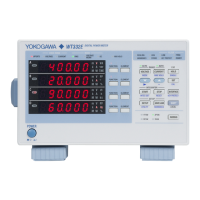App-23
IM WT310E-01EN
Appendix
App
Power Factor Influence (Power Factor Error)
The previous example was for when the phase difference between the voltage and current signals was
0°, or in other words, when the power factor was 1. Next, we will calculate the error for an example in
which the power factor is not 1.
When the Power Factor is 0
This is an example for when the phase difference is 90°, or in other words, when the power factor is
0.Theoretically,theactivepoweris0W,apparentpoweris80VA,andthereactivepoweris80var.
This assumes an ideal capacitive (C) load or an ideal inductive (L) load. For details, see appendix 2.
Whenthepowerfactor(λ)=0,thepowererroronthisinstrumentisdefinedasfollows:
±0.1%ofS(S:apparentpower)inthe45Hz≤f≤66Hzrange
Whenthemeasuredapparentpoweris80.00[VA],theerrorinthemeasuredpower(0.00W)isas
follows:
80.00×±0.1%=±0.08[W]
When the Power Factor Is Greater Than 0 but Less Than 1
Asanexample,letuscalculatetheerrorforwhenthepowerfactoris0.5,orinotherwords,when
thephasedifferencebetweenthevoltageandcurrent(Φ)is60°.
• Voltagemeasurementrange:150V,measuredvoltage:100.00V
• Currentmeasurementrange:1A,measuredcurrent:0.800A
• Powermeasurementrange:150W,measuredpower:40.00W,measuredapparentpower:
80.00VA,measuredreactivepower:69.28var
When0<λ<1,thepowererroronthisinstrumentisdefinedasfollows:
(Powerreading)×[(powerreadingerror%)+(powerrangeerror%)×(powerrange/indicated
apparentpowervalue)+{tanΦ×(influencewhenλ=0)%}],
If we substitute the above value into this equation, the power error becomes as follows:
40.00[W]×[0.1%+0.05%×(150/80.00)+{tan60°×(influence(%)whenλ=0)}]
=40.00[W]×{0.1+0.05×(150/80.00)+√3×0.1}%
=0.1468[W]
Theerrorinthemeasuredpower(40.00W)is±0.1468[W].
Appendix 5 Measurement Accuracy and Measurement Error

